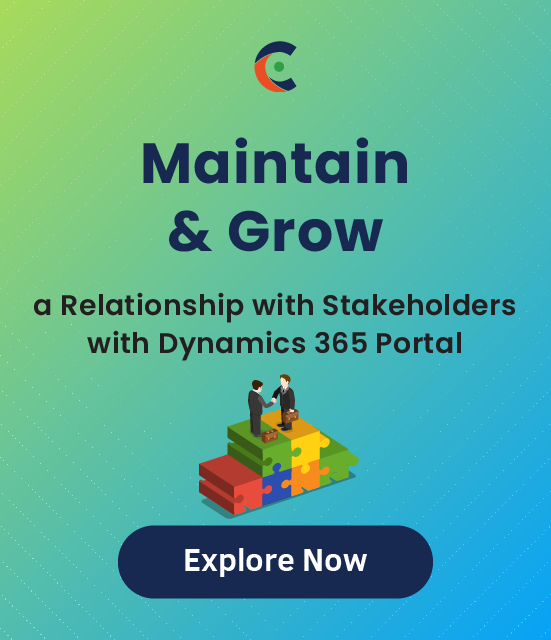Every day, thousands of businesses worldwide are boosting productivity, saving costs, and earning better returns by moving from paper-based systems to paperless digital solutions that amplify the daily grind.
Document management systems can easily integrate with your existing solution and improve workflow efficiency. But that’s too ‘90s! Integrating multiple third-party solutions and configuring them to work together creates chaos and might slow down the ERP solution. On top of that, these legacy systems can result in compromised security, compliance risk, unorganized databases, cluttered network drives, etc.
Even amidst all these challenges, managing documents is essential, and going digital is the only solution. Using a customer portal for Dynamics document management is one of the best options. In this article, I will explain why.
You may think – why not integrate Dynamics 365 rather than a customer portal. I will answer that too in a proper way.
Before that, let’s look at the technical definition of document management in Dynamics 365, why you need it, and why you should get rid of legacy systems.
What is Document Management?
Document management is a set of practices that defines how businesses manage, store, and track their data. This data can be in various formats like emails, images, documents, etc. However, the principle of document management remains consistent.
A document management system is software that helps businesses manage documents. Here, they can store documents, categorize them, retrieve, share, edit, track, and do a lot more activities. Document management systems help control access and protect sensitive information.
The common components of document management include:
- Storage
It provides a centralized location for storing documents from where authorized users can easily access them.
- Annotations
Allows adding notes and comments to the document without a need to edit it.
- Version Control
Tracks and records the new versions of the documents so that you can view history and restore it if required.
- Audit Trails
Enables authorized users to view the log of who edited or viewed the documents and when.
- Security and Access Control
Ensures only limited authorized users can access the documents.
These components play an important role in securing your business’ information. Hence, it’s essential that you choose the right solution for managing documents.
Why You Need a Proper Digital Solution for Document Management
The question you might be having is, “Why should I spend money on a separate tool when I can purchase the cloud storage and store documents there?”
Say you have a law firm, which means you likely handle hundreds and thousands of documents daily.
There’s a murder case that’s similar to the one from 5 years back. To solve this case, you need data from the previous case. You can look for documents on Google Drive. However, it may take up a lot of time if you don’t know the proper names or the location of the documents/folder. Even after having it digitally stored, you can end up losing potential productive hours.
Likewise, if you have a proper document management system, you can create a central repository of your existing content and get rid of the digital clutter. You can easily access the information and focus on your work. Share documents with opposing counsel or clients. Limit access to the documents. Search the documents quickly thanks to indexing and categorizing capabilities.
In simple words, a Dynamics document management system makes it easier to handle documents, in many ways, automates the workflow. However, you should avoid adopting legacy systems. Here’s why:
- Outdated Technology: These old-school solutions are not prepared for change. Using them is like using Excel sheets in the world of Slack and Trello for project management.
- Security Concern: Modern solutions are updated continuously to meet the latest threats. However, traditional systems find it difficult to adapt because of their nature and thus leaves room for vulnerabilities.
- Compatibility Issues: Legacy systems support documents and file formats up to a point. It means you’re stuck with formats that your partners, customers may not be willing to use.
- High Maintenance: These old systems come at a low price, but with time, the expenses increase. The support and updates for outdated technologies are costly as it takes more effort for developers to continue maintenance and updates.
- Poor Customer Experience: It’s difficult for you to communicate with your customers who keep moving with the latest technological advancements. Up of that, the 3rd party solution may lack customer-centric features, making it difficult for customers to access, collaborate, or communicate with you.
You shouldn’t go for outdated or third-party integrations. So, what should you do?
Solution: Bring in a customer portal. Well, you can also use the native Dynamics CRM for document storing. But I won’t suggest that to you because it has limitations.
Document Management in Dynamics 365
Dynamics CRM is not a document management or storage system. It handles the important aspects of your business, i.e., customer engagement, and hence most businesses think it’s fine to use it for document storage.
The main advantage of Dynamics document management is having documents accessible directly from the related records. All the records are linked to the accounts, and there’s no need for additional search.
However, documents in Dynamics are stored as attachments to the record form. It means all the attachments and notes add up in Dynamics over time, consuming space. On top of that, the native solution doesn’t offer any search ability within documents, nor there’s a version control feature. You end up scrolling down the timeline to find the document version, which is not productive.
Also, there’s no feature to prevent users from updating the documents simultaneously. Your non-CRM users can’t access the documents. Documents can’t be categorized or stored as metadata that describes the document, such as the status and author of the document. Another potential limit of document management in Dynamics 365 is the volume. If you have a large number of documents, the size of the database increases, and it can increase the expense if you’re paying for storage.
Dynamics 365 doesn’t allow collaboration. The attachments have a size limit of 5-9 MB max, which is not mind-blowing.
What can you do about it?
If you’re storing a few documents that too occasionally, you can configure document management in Dynamics 365. That’s a reasonable approach. For others, the recommendation is to integrate a Dynamics customer portal.
Oh yes! Dynamics allows SharePoint integration to overcome the challenges of native solutions.
SharePoint Integration
SharePoint is built for document management. With no additional costs, you can get multiple features that CRM doesn’t provide. For example, each document can have metadata to facilitate searches. Non-CRM users can access the documents using SharePoint functionality. All the native CRM features are switched to standard SharePoint functionalities. This gives you a feeling of managing documents directly from SharePoint.
SharePoint balances the limitations of native Dynamics CRM but to an extent. You might experience resource throttling when the item limit exceeds 5000. There’s no backup in SharePoint. If you delete a file and fail to restore it within 93 days, the document is gone forever.
SharePoint has sync limitations. Users cannot see documents when multiple entities/users try to access the same SharePoint document location. It doesn’t support Dynamics 365 editable grids. This limits SharePoint from working properly. For example, the document fails to load in the grid. You can’t create or upload documents. It also disables searching in the grid.
Most importantly, SharePoint integration ignores the privileges you set on the Dynamics CRM side. It means everyone can access the documents, and that can be dangerous.
Making your documents tamper-proof is essential, and for that, it’s important that you use a solution that guarantees security along with customer satisfaction.
Having a customer portal for D365 document management streamlines the communication. It curbs all the challenges of the legacy systems and the limitations of CRM and third-party integrations.
Dynamics 365 Customer Portal provides a secure place for data sharing, document approval, invoices, billing, and more. It fosters collaboration and enhances engagement with features like self-service, knowledge base, and community support.
With Dynamics customer portal, you get more flexibility and security. CRMJetty can help you with it. We offer a ready-to-integrate Dynamics portal solution. Talk with our team to know how it can work for you.
Why You Should Choose Portal for Document Management in Dynamics 365
By implementing a customer portal, a business can get their documents in order and take advantage of the following benefits/features:
- Increase Transparency
Whether it’s reviewing contracts, processing invoices, or collecting forms, it’s essential that you, your staff, and customers can find all the documents whenever required. The Dynamics customer portal puts all the documents in a separate document management module, ensuring everyone has the same information. Multiple users can access the same document simultaneously. They can edit and make changes to the documents based on their access rights.
This centralized repository serves as the source of truth in the organization.
- Quick Search
Regardless of size or format, you can easily search the right document using metadata, versions, keywords, and categories linked to it. Technologies like AI and machine learning further enhance document search capabilities.
- Share Content
The capability to share data with customers safely and securely is critical for many organizations. Emails are not that secure. Hence, the portal offers an internal document sharing feature to speed up the process—details like who accessed it and when, help enhance transparency.
- Foster Collaboration
Customer portals allow employees and customers to collaborate and work on the document together in real-time. This process eliminates the back and forth editing in the email threads.
- Track Versions
Feature-rich customer portals have built-in version control. This helps users to track the document changes and ensures they are working with the most up-to-date versions.
- Protect Sensitive Information
Dynamics customer portal offers role-based access that lets admin grant or deny access to the documents. This ensures that only the authorized users can access the documents and security is effective.
- Support Compliance Regulations
Along with limited access, the portal provides audit trails, i.e., logs of system activity, including document edits, login attempts, and user permission changes. This maintains transparency and ensures that your organization follows compliance.
- Access Information from Anywhere
With cloud-based technology, you and your customers can access the documents from anywhere, anytime. This ease of access ensures that information can be communicated with everyone, including the project head and stakeholders, no matter where they are. Also, most cloud technology automatically backs up the content, providing a foundation for quick recovery.
There are many other ways in which a customer portal can benefit organizations and improve their operations. Want to know how you can benefit?
How Does Our Dynamics Customer Portal Help You?
We offer a ready-to-integrate Dynamics 365 customer portal for all your business requirements. Our portal is fully compatible with Microsoft Dynamics 365 and allows customization in real-time. For document management in Dynamics 365, we offer two options:
- SharePoint Integration
To streamline Dynamics document management and customer engagement. We know about the limitations of SharePoint, and thus, we offer a custom module too.
- Custom Document Management Module
This module works exactly like a document management system and has all the features explained in the above section. Either you can choose to combine both – custom module and SharePoint for outstanding results or opt to go for Dynamics document management only.
- Additional Features
Apart from document management in Dynamics 365, our portal offers a custom dashboard, entity management, content management, drag and drop builder, configurable widgets and themes, page-level access, third-party integrations, etc.
It means you can offer 360-degree customer service that covers everything from tickets and cases to self-help, document sharing, and more. Our Dynamics solution simplifies your business operations and helps establish a strong connection with your customers.
Ready to take the next step?
All product and company names are trademarks™, registered® or copyright© trademarks of their respective holders. Use of them does not imply any affiliation with or endorsement by them.







